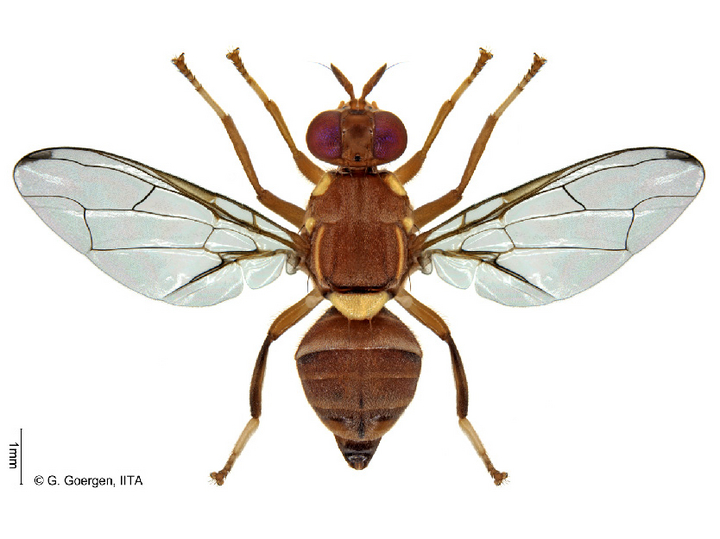Peach fruit fly
Bactrocera zonata
Appearance

Die Abbildung der Adulten Pfirsichfruchtfliege "Bactrocera zonata female" von G. Goergen IITA ist lizenziert unter CC BY 4.0
The peach fruit fly belongs to the fruit fly family (Tephritidae).
The adult flies are about 5 mm in size and predominantly orange to brownish in color. They have a yellow dorsal shield and have a dark spot in the wing tip.
The larvae (maggots) are white to cream colored, up to 1 cm long in the last larval stage, and have a black mouth hook.
Biology
Females of the peach fruit fly lay eggs under the skin of ripening fruit. After a few days, the larvae hatch from the eggs and feed on the flesh of the fruit. They develop inside the fruit, but leave it in the last larval stage and drop to the ground. In the soil under the host plant, pupation occurs and the adults hatch from the pupae. The entire development cycle is temperature dependent and lasts several weeks under optimal conditions (25 °C - 30 °C). The adults can live for several months and the females lay several hundred eggs during this time.
Damage symptoms
Egg laying results in punctate puncture marks on infested fruit. The larvae feed in the fruit and destroy the flesh. This can lead to rotting of the fruit. Due to the feeding activity of the larvae, considerable damage can occur inside the fruit even before symptoms are externally visible. In the early stages of infestation, symptoms of damage are difficult to see. Peach fruit flies attack only the fruit, so there is no damage to other parts of the plant, such as leaves, trunk, branches or roots.
Host plants
As a polyphagous fruit fly (i.e., it can feed on many different plants), the peach fruit fly has a large number of potential host plants. The main host plants are guava(Psidium guajava), mango(Mangifera indica), and peach(Prunus persica). In addition to these main host plants, a total of over 50 secondary hosts are known which can be used alternatively for development. These include important native cultivated plants such as apricot(Prunus armeniaca), apple(Malus domestica) or pear(Pyrus spp.).
Distribution
The peach fruit fly originates from Asia (e.g. India, Bangladesh, Thailand, Pakistan), and has been present in the Arabian Peninsula since the 1980s and in northern Africa (e.g. Egypt, Libya) since the 1990s. It has been able to re-establish itself in some countries (e.g. Egypt), but in others it has also been eradicated, at least temporarily (e.g. Israel, USA). In Austria, individual specimens of the peach fruit fly have been found in recent years, although this is not an established population. In this country, establishment of the peach fruit fly can be ruled out due to winter conditions. Established populations are also not known from other countries of the European Union so far.
Propagation and transmission
The spread of the peach fruit fly can be active or passive. Carryover by means of infested fruit (commercial goods, luggage of travelers) to previously uninfested areas is considered the most important mode of spread. In addition, passive spread can also occur by wind dispersal. Active dispersal occurs by the flight of adults up to 25 km.
Prevention and control
- To detect the occurrence (monitoring) of the peach fruit fly: Attach suitable fruit fly traps (e.g. Delta traps, McPhail traps, ...) to catch the adults using specific attractants:
- Parapheromone (methyl eugenol) to attract males
- protein-based, to attract female flies
- There are currently no plant protection products authorised against this pest in Austria (see list of plant protection products authorised in Austria)
Phytosanitary status
Non-European fruit flies (Tephritidae) such as the peach fruit fly are listed as Union quarantine pests of the European Union and are thus subject to legal regulations to prevent their introduction and spread into or within the member states of the EU. Please observe the obligation to notify in case of an occurrence and contact the official plant protection service of your federal state.
Specialist information
Research
Since 2012, we and the official plant protection services of the federal states have been continuously monitoring the occurrence of the peach fruit fly and other important fruit fly species in Austria.
We are also involved in various European and international co-operations and projects on fruit flies
EUPHRESCO network project FLY DETECT
H2020 project: FF-IPM - Fruit Flies In-silico / Prevention & Management
Publications
Milonas, P., Egartner, A., Ivanova, I., 2020. Development and implementation of early detection tools and effective management strategies for invasive non-European and other selected fruit fly species of economic importance (FLY DETECT). Zenodo. doi. org/10.5281/zenodo.3732297
Egartner, A., Lethmayer, C., Gottsberger, R. A., Blümel, S., 2019. Survey on Bactrocera spp. (Tephritidae, Diptera) in Austria. Bulletin OEPP/EPPO Bulletin 49(3). doi. org/10.1111/epp.12604
Lethmayer, C., Egartner, A., 2019. Invasive flies in domestic fruit production. Better fruit 8, 7-8.
Lethmayer, C., 2011. Dangerous flies for apples & co. Better Fruit 12, 4-5.
Last updated: 28.10.2024
automatically translated